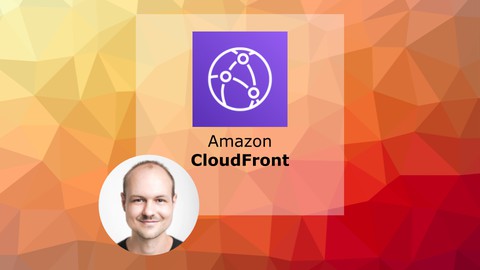
The cloud architect's guide to CloudFront
The cloud architect's guide to CloudFront, available at $29.99, has an average rating of 3.75, with 13 lectures, based on 12 reviews, and has 60 subscribers.
You will learn about Speed up web applications with a CDN Debug a CloudFront configuration Add a custom domain name to a distribution How to add different types of backends This course is ideal for individuals who are AWS architects who want to speed up content delivery for webapps It is particularly useful for AWS architects who want to speed up content delivery for webapps.
Enroll now: The cloud architect's guide to CloudFront
Summary
Title: The cloud architect's guide to CloudFront
Price: $29.99
Average Rating: 3.75
Number of Lectures: 13
Number of Published Lectures: 13
Number of Curriculum Items: 13
Number of Published Curriculum Objects: 13
Original Price: $39.99
Quality Status: approved
Status: Live
What You Will Learn
- Speed up web applications with a CDN
- Debug a CloudFront configuration
- Add a custom domain name to a distribution
- How to add different types of backends
Who Should Attend
- AWS architects who want to speed up content delivery for webapps
Target Audiences
- AWS architects who want to speed up content delivery for webapps
CloudFront is AWS’s content delivery network. It consists of more than 200 edge locations around the world, which makes sure no visitor is too far from one of them. Each edge is a full-fledged data center, connected by dedicated data cables which makes the connection reliable and fast.
You can take advantage of this global network with the CloudFront service. Using it, you can route your users to locations closer to them, making the waiting times between pressing enter and seeing the results a lot shorter.
But CloudFront is not just about moving connections closer to users. It is also a routing engine, a proxy that sits between the visitors and the servers. You can configure path-based routing where a visitor uses a single connection to communicate with multiple backend services. This hides the complexities of an architecture consisting of multiple services, and also allows a single point of contact where you have a single point to configure modern communication protocols and all the other services benefit from it. You can use HTTP/2, IPv6, and your custom domain name even with services that do not support them.
On the other hand, CloudFront is not easy to configure. Routing itself has multiple parts that can break if you are not careful, and setting up caching is a lot more complicated than what the relatively simple interface would suggest.
In this course, you’ll learn how to use CloudFront from the ground up. We’ll start with a high-level overview of the service and the key terms that are all over the documentation and the console. Then we’ll move on to the finer details of the available configuration options. The two most important and error-prone concepts, routing and caching, are discussed in-depth, as well as how to use your own domain name.
During the course, you’ll see the best practices and the common problems with configurations, and also how to debug CloudFront when something is not working.
This course is for architects who have some experience with the AWS platform. We won’t go into detail how to configure an S3 bucket or how to create an API Gateway, but no prior experience with CloudFront is necessary.
Course Curriculum
Chapter 1: Getting to know CloudFront
Lecture 1: What is CloudFront
Lecture 2: Benefits of CloudFront
Lecture 3: Terminology
Lecture 4: Additional terminology
Chapter 2: Configuration
Lecture 1: Distribution configuration
Lecture 2: Origin configuration
Lecture 3: Cache behavior configuration
Lecture 4: Routing
Lecture 5: Caching
Chapter 3: Specific topics
Lecture 1: Debugging
Lecture 2: S3 bucket origin
Lecture 3: Custom domain
Lecture 4: Pricing
Instructors
-
Tamás Sallai
AWS Certified Security Specialist
Rating Distribution
- 1 stars: 1 votes
- 2 stars: 3 votes
- 3 stars: 1 votes
- 4 stars: 4 votes
- 5 stars: 3 votes
Frequently Asked Questions
How long do I have access to the course materials?
You can view and review the lecture materials indefinitely, like an on-demand channel.
Can I take my courses with me wherever I go?
Definitely! If you have an internet connection, courses on Udemy are available on any device at any time. If you don’t have an internet connection, some instructors also let their students download course lectures. That’s up to the instructor though, so make sure you get on their good side!
You may also like
- Top 10 Financial Technology Courses to Learn in December 2024
- Top 10 Agile Methodologies Courses to Learn in December 2024
- Top 10 Project Management Courses to Learn in December 2024
- Top 10 Leadership Skills Courses to Learn in December 2024
- Top 10 Public Speaking Courses to Learn in December 2024
- Top 10 Affiliate Marketing Courses to Learn in December 2024
- Top 10 Email Marketing Courses to Learn in December 2024
- Top 10 Social Media Management Courses to Learn in December 2024
- Top 10 SEO Optimization Courses to Learn in December 2024
- Top 10 Content Creation Courses to Learn in December 2024
- Top 10 Game Development Courses to Learn in December 2024
- Top 10 Software Testing Courses to Learn in December 2024
- Top 10 Big Data Courses to Learn in December 2024
- Top 10 Internet Of Things Courses to Learn in December 2024
- Top 10 Quantum Computing Courses to Learn in December 2024
- Top 10 Cloud Computing Courses to Learn in December 2024
- Top 10 3d Modeling Courses to Learn in December 2024
- Top 10 Mobile App Development Courses to Learn in December 2024
- Top 10 Graphic Design Courses to Learn in December 2024
- Top 10 Videography Courses to Learn in December 2024






















